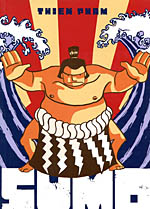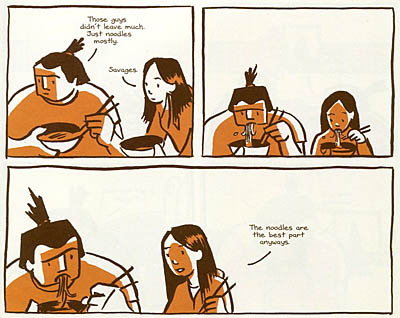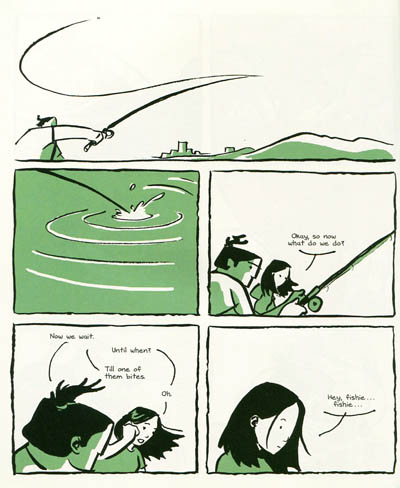 By Thien Pham
By Thien Pham
112 pages, color
Published by First Second Books
Thien Pham is one of those creators whose comics I’ve seen in small doses here and there over the years, primarily in mini-comic form. So with the release of Sumo, his first graphic novel as both writer and artist, I was eager to see just what he’d turn out. His minis have always been pleasing but short, and the expanded page count had the potential to deliver something quite interesting. As it turns out, Sumo is a book that uses its page length perfectly.
 Pham tells the story of Scott, a former football player who’s moved to Japan to become a sumo wrestler. With his blonde hair died black and given the name Hakugei for wrestling, outwardly Scott’s made a complete transformation as part of his new career. But inwardly, Scott is still struggling with his confidence and the emotional fallout from a relationship gone bad. It’s a simple story but in many ways that’s part of Sumo‘s appeal.
Pham tells the story of Scott, a former football player who’s moved to Japan to become a sumo wrestler. With his blonde hair died black and given the name Hakugei for wrestling, outwardly Scott’s made a complete transformation as part of his new career. But inwardly, Scott is still struggling with his confidence and the emotional fallout from a relationship gone bad. It’s a simple story but in many ways that’s part of Sumo‘s appeal.
Pham’s story jumps back and forth between the present day and flashbacks to two earlier times; before he left the United States, and soon after his arrival in Japan. At first each of the two flashback settings appear when Scott’s own viewpoint has temporarily ended—getting knocked out during a practice, or taking a nap—but the second time through they act more as scene breaks. It’s a lot to be said for Pham that both methods work quite well; the early transitions ease the reader into the shift, the later ones just return when it feels natural to pick up with more information about those earlier times (and the relationships that ended and began for Scott). Pham makes sure his readers don’t get lost by performing a color shift on those pages; instead of the black-and-orange of the present day, we get black-and-blue for the US and black-and-green for Japan. It’s a simple but visually pleasing way to show the change in setting, and Pham uses it masterfully as part of the climax later in the comic.
 The art in Sumo is very straightforward. Pham draws with just a handful of lines, and it’s a decision that feels absolutely right for this story. An over-rendered Sumo would take away from the quiet mood of the book, and he’s able to still bring across all the emotional heft of the story through his characters and their expressions. The motion is great; not just in the match, but also bits like the flick of a fishing line across the air that arcs across the page perfectly. I found myself entranced at times with some of the little details of the story, like how the lowest-ranked sumo trainees are the ones responsible for the food, or how Scott promptly had his hair dyed upon entering the school. Those are all moments that don’t draw any real attention to themselves (besides occurring), but in which you drink in the details through the art. The world of the sumo wrestler trainee is a foreign one to most Western audiences, and while reading Sumo isn’t a primer (and isn’t meant to be), it still gives you a glimpse into this new world. Even the lettering is handled gracefully, with just enough of a balloon rendered as you need for each individual panel and page.
The art in Sumo is very straightforward. Pham draws with just a handful of lines, and it’s a decision that feels absolutely right for this story. An over-rendered Sumo would take away from the quiet mood of the book, and he’s able to still bring across all the emotional heft of the story through his characters and their expressions. The motion is great; not just in the match, but also bits like the flick of a fishing line across the air that arcs across the page perfectly. I found myself entranced at times with some of the little details of the story, like how the lowest-ranked sumo trainees are the ones responsible for the food, or how Scott promptly had his hair dyed upon entering the school. Those are all moments that don’t draw any real attention to themselves (besides occurring), but in which you drink in the details through the art. The world of the sumo wrestler trainee is a foreign one to most Western audiences, and while reading Sumo isn’t a primer (and isn’t meant to be), it still gives you a glimpse into this new world. Even the lettering is handled gracefully, with just enough of a balloon rendered as you need for each individual panel and page.
What struck me the most about Sumo was the simple elegance of the graphic novel. It’s a quiet story that quietly builds to a crescendo; similar to the way that sumo wrestlers circle one another at first, Sumo does an almost graceful dance around the conclusion. You know that it’s all coming to a head when the match hits, and sure enough, that’s when everything comes fast and curious. Flashbacks hit left and right, Scott is losing chances to get that win he needs to stay in the program, and then that final moment appears… and the reader is left to slowly exhale. With the final pages providing a simple but beautiful closing image, it helped cement Sumo to me as a real gem. Whatever Pham’s next project is, I’m already lined up as a reader. Nicely done.
Purchase Links: Amazon.com | Powell’s Books
